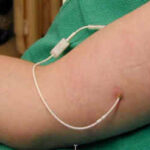A PICC line- or Peripherally Inserted Central Catheter- is a form of IV line. Rather than needing to be pulled out and put in a new spot every 3 to 5 days like a regular IV line, it can be left in place for months, saving a lot of pain. It is frequently used when concentrated medications (like chemotherapy agents) which can irritate the smaller veins are being given. Some of these meds, when given by regular IV line, can be very painful. The PICC line can also be used for blood draws, saving numerous vein sticks for the patient. Multiple ports can be installed, making it easier to give multiple meds or solution. It’s called a ‘central catheter’ because it delivers the medications to an ‘central’ area right above the heart, where it disperses all over the body right away, rather than into a small vein in the arm where it takes awhile to get to the heart.
Like a sub-clavian line, the PICC delivers the meds to the large veins right above the heart. But a sub-clavian line is installed right under the collar bone, a site that carries a significantly higher risk of infection than the arm site that a PICC uses. The PICC can be installed by a trained RN, an IV specialist or a trained radiologist (X-ray technician). You will not be put to sleep for this process. The entry site for a PICC is on the arm, usually by the wrist, in a site frequently used by regular IVs.
The installation takes about an hour and a half to two hours, with a guide wire being inserted into an arm vein to lead the soft, hollow, spaghetti like tube into its place, with the tip of the PICC resting in one of the large veins right above the heart. After insertion, its position is confirmed by a simple X-ray and the guide wire is removed. There is normally little discomfort involved with this process. The external end is secured on your arm with either tape or a stitch or two; the site will be numbed with a local anesthetic if stitches are used. The catheter is soft enough that the arm can be bent normally while it is in. When you no longer need the PICC, an RN can remove it right in your room. It pulls out like a long worm, usually painlessly, in a process that only takes a minute. It leaves a small hole that is given a bandage just as if you had merely had blood drawn.
All things medical have risks, of course. Any opening in the body presents a risk of infection, but the risk with a PICC is very low. If the tip of the catheter is placed too close to the heart, an irregular heartbeat can occur; this is remedied by pulling the line back some. As with a regular IV line, a local inflammation or a blood clot can occur. Clots are removed with TPA, the medication known as the ‘clot buster’ that saves many heart attack victims. If the clot is in the port (the external site that the nurses put the meds into), the TPA never enters your body.
A few precautions must be taken with your PICC line. Like an IV port, stitches or non-standard body opening, the PICC port should not be exposed to water. Bathing and hot tubbing is out; when you shower, the PICC should be covered with plastic. No heavy lifting should be done, and excessive arm movement is discouraged- the PICC is very flexible, but excessive movement can irritate the vein it’s in. And a blood pressure cuff must NOT be used on the arm the PICC is in.
All things considered, a PICC line is a great choice for long hospital stays or when long term IV treatment is to be given. It’s a safe method that reduces the amount of pain and infection risk that you’ll be facing.


